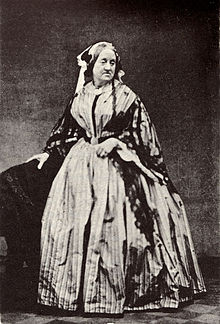Anna Atkins
| Anna Atkins | |
|---|---|

Portrait from 1861
|
|
| Born |
March 16, 1799 Tonbridge |
| Died | June 9, 1871 (aged 72) Halstead Place, Sevenoaks paralysis, rheumatism, and exhaustion |
| Fields | Botany, Photography |
| Known for | Very early botanical photographs, 1843 book Photographs of British Algae: Cyanotype Impressions (1st book illustrated with photographic images) |
| Influences | |
| Spouse | John Pelly Atkins |
Anna Atkins (née Children; 16 March 1799 – 9 June 1871) was an English botanist and photographer. She is often considered the first person to publish a book illustrated with photographic images. Some sources claim that she was the first woman to create a photograph.
Atkins was born in Tonbridge, Kent, England in 1799. Her mother Hester Anne Children "didn't recover from the effects of childbirth" and died in 1800. Anna became close to her father John George Children. Anna "received an unusually scientific education for a woman of her time." Her detailed engravings of shells were used to illustrate her father's translation of Lamarck's Genera of Shells.
In 1825 she married John Pelly Atkins, a London West India merchant, and they moved to Halstead Place, the Atkins family home in Sevenoaks, Kent. They had no children. Atkins pursued her interests in botany, for example by collecting dried plants. These were probably used as photograms later.
John George Children and John Pelly Atkins were friends of William Henry Fox Talbot. Anna Atkins learned directly from Talbot about two of his inventions related to photography: the "photogenic drawing" technique (in which an object is placed on light-sensitized paper which is exposed to the sun to produce an image) and calotypes.
Atkins was known to have had access to a camera by 1841. Some sources claim that Atkins was the first female photographer. Other sources name Constance Talbot, the wife of William Fox Talbot, as the first female photographer. As no camera-based photographs by Anna Atkins nor any photographs by Constance Talbot survive, the issue may never be resolved.
Sir John Herschel, a friend of Atkins and Children, invented the cyanotype photographic process in 1842. Within a year, Atkins applied the process to algae (specifically, seaweed) by making cyanotype photograms that were contact printed "by placing the unmounted dried-algae original directly on the cyanotype paper."
...
Wikipedia
